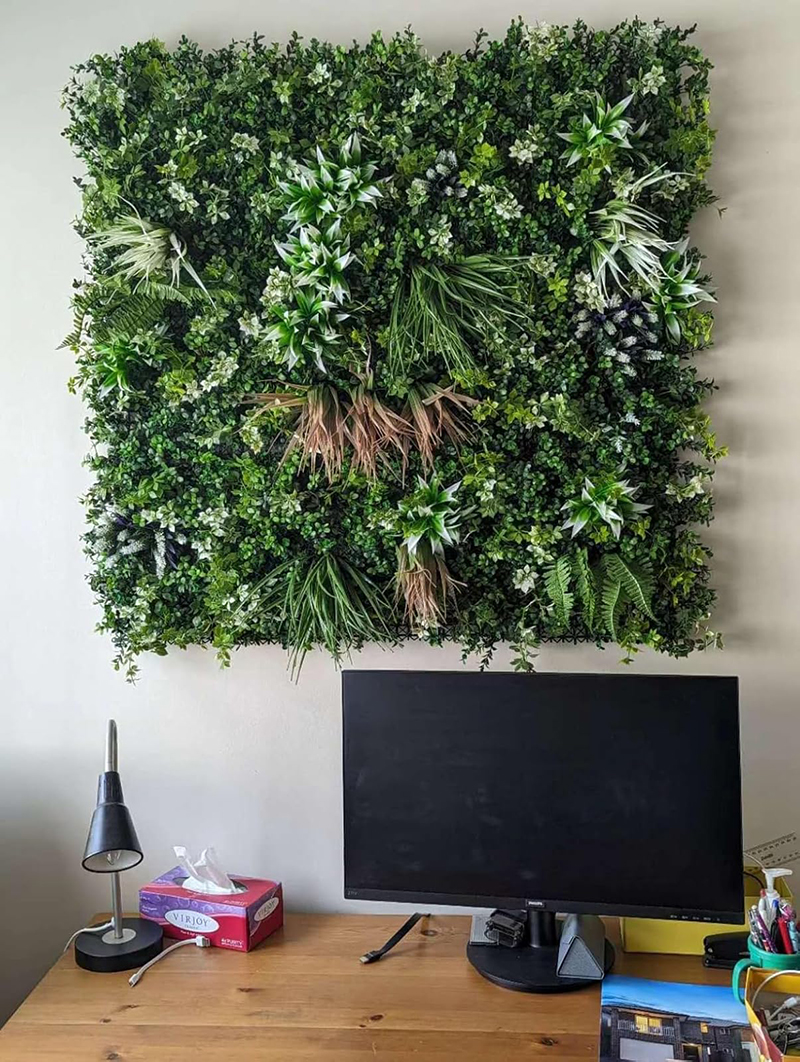Mixed Planting Techniques for 3D Artificial Vertical Gardens: Achieving Natural Harmony Through Strategic Combinations
Creating a visually compelling 3D artificial vertical garden requires more than selecting individual plants—it involves blending varieties in a way that mimics the organic diversity of natural ecosystems. Mixed planting enhances depth, texture, and color dynamics, ensuring the garden feels lush and dynamic even without living growth. By considering factors like plant shape, scale, and seasonal adaptability, designers can craft arrangements that remain engaging year-round. Below are key strategies for mastering mixed planting in artificial vertical gardens.

The interplay of different plant shapes creates visual interest and prevents the garden from appearing monotonous. Combining upright, trailing, and rounded forms adds rhythm and movement, making the design feel alive.
Upright Plants as Structural Anchors: Use tall, vertical artificial plants, such as faux snake plants, dracaenas, or cordylines, to establish the garden’s framework. These varieties provide height and stability, serving as focal points that draw the eye upward. Place them strategically to break up horizontal lines and add vertical emphasis.
Trailing Plants for Softening Transitions: Incorporate cascading artificial vines, ivy, or string-of-pearls to drape over container edges or down the wall. These plants soften the hard edges of the structure and create a sense of flow between layers. Their delicate foliage contrasts beautifully with bolder upright varieties, adding elegance to the design.
Rounded Plants for Filling Gaps: Fill in empty spaces with artificial plants that have full, rounded forms, such as faux ferns, hostas, or peonies. These varieties add volume and balance, ensuring the garden looks lush without feeling overcrowded. Their soft shapes also provide a counterpoint to spiky or angular plants, creating harmonious contrast.
Texture is a powerful tool in artificial garden design, as it adds complexity and realism even without the tactile feedback of living plants. Mixing rough, smooth, and feathery textures creates a multi-dimensional effect that engages viewers from every angle.
Rough Textures for Earthy Appeal: Integrate artificial plants with rough, bark-like surfaces or deeply veined leaves, such as faux monstera or philodendron varieties. These textures evoke a sense of natural ruggedness and pair well with smoother plants, grounding the design in organic authenticity.
Smooth Textures for Modern Contrast: Use artificial succulents, aloes, or agaves with glossy, waxy leaves to introduce a sleek, contemporary element. Their reflective surfaces catch light differently than matte textures, adding visual intrigue and creating focal points within the garden.
Feathery Textures for Ethereal Movement: Incorporate delicate, fine-leaved artificial plants, such as faux asparagus ferns or mimosas, to simulate the gentle movement of real foliage in the breeze. These textures add lightness and airiness to the garden, preventing it from feeling too heavy or dense.
While artificial plants do not change color with the seasons, their hues can still be arranged to evoke different moods or mimic natural transitions. Strategic color layering ensures the garden remains visually engaging throughout the year.
Monochromatic Schemes for Sophisticated Elegance: Create a cohesive look by sticking to a single color family, such as various shades of green, and varying the textures and shapes instead. This approach works well for minimalist or modern designs, where subtlety is key.
Complementary Colors for Vibrant Contrast: Pair opposite colors on the wheel, such as deep greens with bright purples or soft yellows with rich blues, to create energy and excitement. For example, faux lavender or violets can pop against a backdrop of artificial ferns or grasses, adding drama to the garden.
Neutral Tones for Timeless Versatility: Incorporate artificial plants with neutral hues, such as whites, grays, or beiges, to serve as a calming base for bolder colors. These tones also help transition between sections of the garden, creating a seamless flow from one area to the next.
Varying the size of artificial plants ensures the garden feels naturally diverse and avoids a uniform, manufactured look. Mixing large, medium, and small varieties creates a sense of scale and depth that mimics real ecosystems.
Large Plants as Statement Pieces: Use oversized artificial plants, such as faux bird of paradise or elephant ears, sparingly to create dramatic focal points. These varieties should be placed where they can be appreciated up close, such as near seating areas or entryways, to maximize their impact.
Medium Plants for Transitional Volume: Fill in the middle ground with medium-sized artificial plants, such as faux calatheas or dieffenbachias, to add fullness without overwhelming the design. These varieties bridge the gap between large statement pieces and smaller filler plants, creating a balanced composition.
Small Plants for Detail and Refinement: Scatter tiny artificial plants, such as faux moss, baby’s tears, or miniature succulents, throughout the garden to add intricate detail. These varieties soften transitions between larger plants and create a sense of abundance, making the garden feel more organic.
By balancing plant shapes, combining textures, layering colors, and integrating scale variations, a 3D artificial vertical garden can achieve a lifelike, dynamic appearance. These techniques ensure the garden remains visually engaging, adaptable to different styles, and intentionally designed, whether installed indoors or outdoors.
Contact: Amy
Phone: 86-15311787313
E-mail: info@foszmac.com
Whatsapp:86-15311787313
Add: Fengtai District, Dacheng Road, No.24 Building, Room 203, Beijing, China